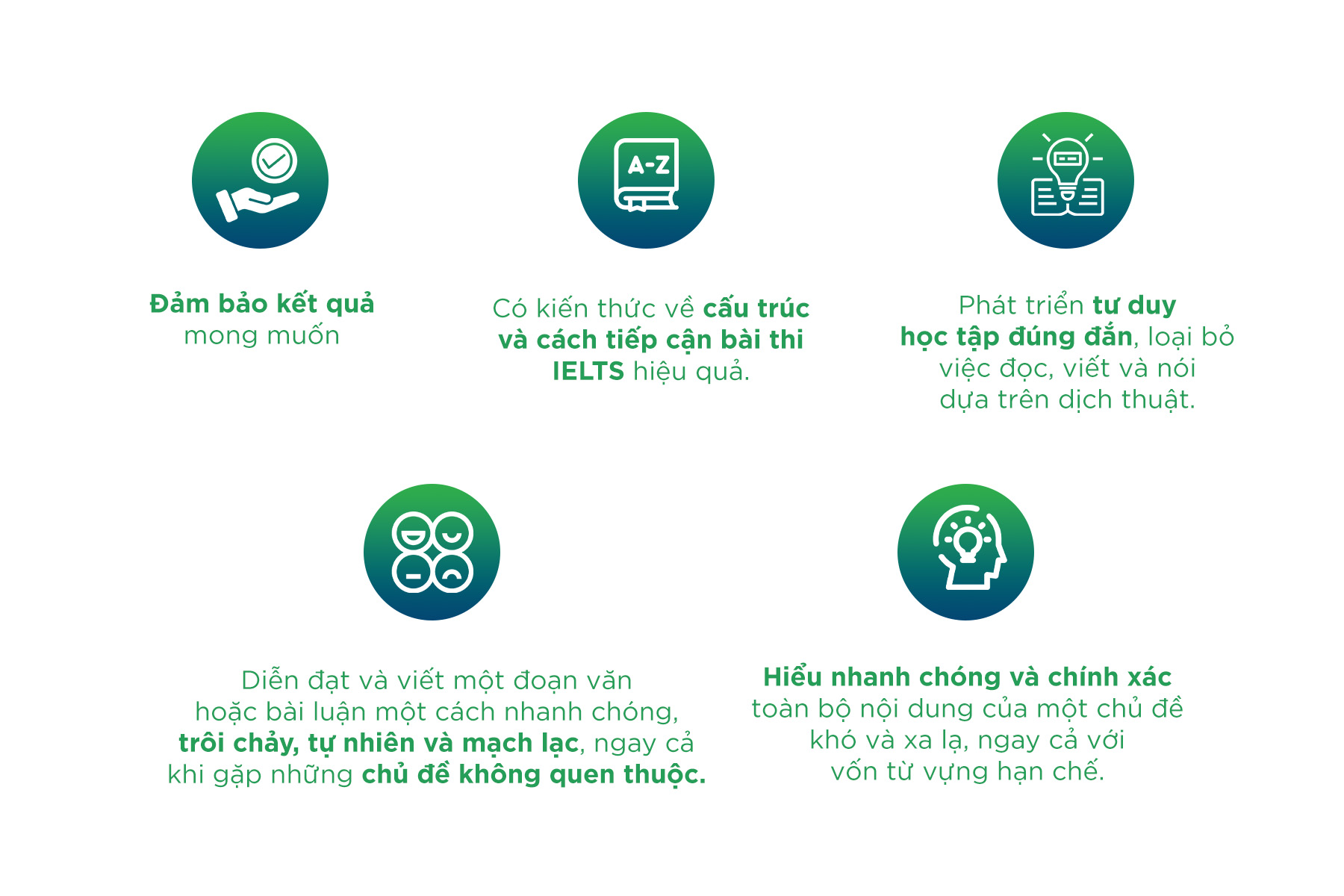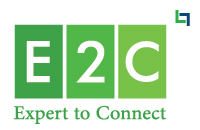Khóa luyện thi IELTS 5.0 – 5.5 tập trung vào 4 nhóm kĩ năng Nghe – Nói – Đọc – Viết giúp học viên đạt chuẩn đầu ra 6.0.
Lộ trình học rõ ràng luyện tập theo từng nhóm kỹ năng riêng biệt dưới sự hướng dẫn của đội ngũ giảng viên 8.0+ IELTS giúp bạn tự tin và được truyền cảm hứng học tập chăm chỉ mỗi ngày.
AI CÓ THỂ THAM GIA KHÓA HỌC NÀY?

- Học sinh, sinh viên cần nộp chứng chỉ IELTS tại trường hoặc để miễn một số kì thi phù hợp với mục tiêu của mình.
- Đối tượng có ý định du học, định cư, sinh sống và làm việc ở các quốc gia nói tiếng Anh.
- Người đi làm có nhu cầu tăng lương, thăng tiến hoặc chuyển đổi công việc hấp dẫn hơn.
BẠN ĐƯỢC GÌ SAU KHÓA HỌC?

- Đảm bảo kết quả mong muốn.
- Có kiến thức về cấu trúc và cách tiếp cận bài thi IELTS hiệu quả.
- Phát triển tư duy học tập đúng đắn, loại bỏ việc đọc, viết và nói dựa trên dịch thuật.
- Diễn đạt và viết một đoạn văn hoặc bài luận một cách nhanh chóng, trôi chảy, tự nhiên và mạch lạc, ngay cả khi gặp những chủ đề không quen thuộc.
- Hiểu nhanh chóng và chính xác toàn bộ nội dung của một chủ đề khó và xa lạ, ngay cả với vốn từ vựng hạn chế.
NỘI DUNG KHÓA HỌC
Khóa luyện thi IELTS 5.0 – 5.5 giúp học viên tập trung ôn tập 4 kỹ năng quan trọng của bài thi IELTS bao gồm 27 bài học trong chương trình:
Lesson 1:
Reading: Changing the mindset of reading English
The lingering challenges of translation reading/skimming and scanning
Applying Strategies to Reading to address the aforementioned issues
Application to real-world reading
Lesson 2:
Writing: Changing the mindset of writing in English
The significance of learning sentence construction
Lingering challenges of translation writing
Essential elements for mastering structured writing
Effective vocabulary learning techniques
Sentence-building exercises from the textbook
Lesson 3:
Speaking: Changing the mindset of speaking in English
Common issues faced by English learners when speaking
Speak in structure
Templates/Framework to develop ideas
Listening 1: Self-practice techniques for listening at home
Homework: transcription 1
Lesson 4:
Reading: Understanding sentence structures
Reading structures
Common basic sentence structures encountered in reading
Applying the analysis of sentence structures to two specific reading passages
Reading and answering: Passage
Lesson 5:
Writing: Enhancing a sentence and connecting two sentences
Self-correction techniques for a sentence
Improving a sentence effectively
Connecting two sentences seamlessly
Review of new concepts
Completing collocation exercises and memorizing the topic “Education”
Lesson 6:
Speaking: Developing response sentences
Identifying issues in students’ idea development
Utilizing 4W1H to develop ideas
Practice session
Connecting ideas between two sentences
Listening 2: How to approach Note Completion tasks
Completing homework for Listening week 2
Practicing fluent responses to daily routine topic questions + studying related collocations
Lesson 7:
Reading: Practice in Reading Structure
Applying the knowledge to read and answer questions (Passage 1)
Applying the knowledge to read and answer questions (Passage 2)
Reading pracice
Lesson 8:
Writing task 2:
Overview of Writing Task 2
Application to a specific writing prompt
Collocation exercise
Studying + completing collocation topic family + relationship
Generate ideas for the essay topic “Taking a Gap Year”
Lesson 9:
Speaking: Using Reason to Develop Ideas
Language for presenting Reason
Practice session
Listening 3: Approach to Flowchart-type tasks
Transcribing Listening 3
Completing homework for Listening week 3
Practicing fluent responses to travel-related questions + studying related collocations
Lesson 10:
Reading: Reading the connection between sentences/paragraphs + answering Multiple Choice questions
Reading connections in Reading
Applying Reading connections to answer Multiple Choice questions
Practice session
Reading and answering
Lesson 11:
Writing: Responding to Advantages & Disadvantages-type prompts
Outlining for Advantages and Disadvantages essays
Paraphrasing essay prompts for effective introductions
Application to a specific writing prompt
Studying model outlines with a mindset approach
Generating ideas for the LMS essay prompt “Cheaper Product”
Lesson 12:
Speaking: Utilizing Feelings/Opinions to Develop Ideas
Language for presenting Feelings/Opinions
Practice session
Listening 4: Approach to Multiple Choice tasks
Transcribing Listening 4
Completing homework for Listening week 5
Practicing fluent responses to technology-related questions + studying related collocations
Lesson 13:
Reading 5: Responding to Matching Headings type questions
Review: Reading Connection + Answering Multiple Choice Questions
Approach to answering Matching Headings questions
Application to two specific reading passages
Reading the Marriage and Holiday passages – answering matching headings questions
Lesson 14:
Writing 5: Responding to Problems & Solutions-type prompts
Review: Responding to Advantages & Disadvantages-type prompts
Outlining for Problems & Solutions essays
Generating ideas for Problems & Solutions essays
Application to a specific writing prompt
Studying outlines for new essay types
Writing essays on Advantages and Disadvantages
Lesson 15:
Speaking 5: Effectively Presenting a Statement
Review: Using Feelings/Opinions to Develop Ideas
Issues with the old way of presenting Statements
Improving the presentation of Statements
Preferences question type
Yes/No question
Practice
Listening 5: Approach to Gapfill/Short answer tasks
Transcribing Listening
Completing homework for Listening 5
Practicing fluent responses to shopping-related questions + studying related collocations
Lesson 16:
Reading: Practicing reading connections for Matching Headings tasks
Practice: Identifying the type of relationship between two sentences
Practice: Summarizing the content of two sentences
Practice: Applying reading connection to complete Matching Headings tasks
Reading full passage: (Matching Headings section)
Lesson 17:
Writing: Practice
Review: Outline for Advantages and Disadvantages essays
Review: Outline for Problems and Solutions essays
Practice: Building paragraphs
Practice: Solving real test prompts for Advantages/Disadvantages and Problems/Solutions essays
Homework
Writing essays
Lesson 18:
Speaking: Crafting Comprehensive Responses
Review: Various Idea Development Tools
Review: Effective ways to present Statements
Practice: Applying to real-life questions
Homework
Listening 6: In-class listening practice
Transcribing Listening
Completing homework for Listening
Practicing fluent responses to technology-related questions + studying related collocations
Lesson 19:
Reading: Approach to completing Gapfill exercises
Review: Approach to completing Matching Headings tasks
Issues with the old approach to Gapfill tasks
Approaching Gapfill tasks
Application to a reading passage
Completing Gap Fill exercises for the passages
Lesson 20:
Writing 7: Describing data in Writing Task 1
Describing data in Task 1
Reading and understanding charts and graphs
Application: Writing a Pie Chart analysis
Completing the report exercises
Lesson 21:
Speaking 7: Responding to Speaking Part 1 questions
Framework for Speaking Part 1
Presenting Statements for Speaking Part 1
Practice: Providing complete responses to Speaking Part 1 questions
Listening 7: Approach to completing Map tasks
Transcribing Listening day 7
Completing homework for Listening
Practicing fluent responses to study abroad-related questions + studying related collocations
Lesson 22:
Reading: Approach to completing True/False/Not Given exercises
Review: Approaching Gap Fill tasks Issues with the old approach to True/False/Not Given tasks
Approaching True/False/Not Given tasks Application to a reading passage
Exercise
Completing the TFNG sections for the passages
Lesson 23:
Writing: Comparative structures in Writing Task 1
Review: Describing data in Task 1
Sentence structures for making comparisons in Writing Task 1
Applying comparison structures to Task 1 essays
Completing exercise on a bar chart
Lesson 24:
Speaking: Responding to Speaking Part 3 questions
Review: Answering Part 1 questions Issues when developing ideas for Part 3
Applying Framework/Templates/Strategies to develop ideas for Part 3
Practice
Summary
Listening 8: Approach to completing Note Completion tasks
Transcribing
Homework
Practice fluent responses to technology-related questions + studying related collocations
Lesson 25:
Reading: Recap and Review
Reading structure and reading connection) in Reading
How to answer different types of questions in Reading
Applying the learned techniques to a complete reading passage
Feedback on progress made during the course
Lesson 26:
Writing: Variations in language + Crafting a complete Task 1 essay
Reviewing: Comparisons in Task 1
Utilizing the Language of Trend in Task 1
Writing an Introduction and Overview for Task 1
Completing a full Task 1 essay
Lesson 27:
Speaking: Recap and Review
Vocabulary review across various topics
Review Part 1,3
Feedback on progress made during the course
Listening: Reviewing how to approach various question types








